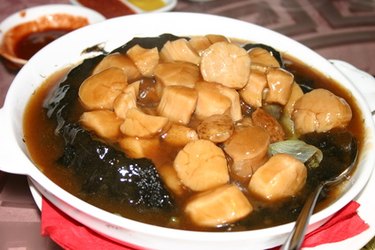Things You'll Need
Paring knife
Dishwasher (optional)
Large bowl
Ice
Paper towels

Nothing ruins the experience of enjoying the smooth texture of a quality scallop like a few grits of sand. Scallops purchased in or out of their shells may hold sand in the folds of the tender raw flesh. A few seconds of washing allows the sandy grit to fall away and leave behind a fully cleaned scallop. Respect the people you feed by giving sandy scallops a proper cleaning before they are cooked and served.
Step 1
Pry open the scallop shells and scrape the shell to release the flesh of the scallop. Both halves of the scallop shells can be scraped free of material with the paring knife and washed in the dishwasher. The cleaned shells can then be used as mini plates in the final presentation of the scallop dish.
Video of the Day
Step 2
Pull away all the brown and green organs, including the gills, kidneys and liver, from the white adductor muscle. It is up to the tastes of the individual cook whether they leave the the pink-orange roe sack attached to the adductor if one is present. Scallop roe has a creamy texture and light delicate scallop flavor.
Step 3
Pinch off the small piece of tough meat on the side of the white adductor muscle. This little muscle will become rubbery and nearly inedible when the scallop is cooked. Scallops that are sold frozen or thawed are usually removed from their shells and everything but the large white adductor and this small side muscle is taken off and discarded.
Step 4
Fill a large bowl about a third full of ice cubes and set the white scallop meat on top of the ice. Add cold water to the bowl until the scallops are completely submerged.
Step 5
Grasp each scallop with clean fingers and gently turn it in all directions underwater to allow any residual sand to be released. Particles of sand will sink and accumulate at the bottom of the large bowl.
Step 6
Lift the cleaned scallops out of the cold water bath and gently pat them dry with paper towels. Drying the surface of the scallops will make them sear faster and develop an even brown crust in the pan when cooked.
Tip
Partially season the scallops after they are cleaned and finish the seasoning after they are cooked. Tasting a cooked scallop before final seasoning will allow you to make adjustments that lead to a balanced flavor. Some cooks choose to pull away the roe sack and sautee it separately from the white adductor muscle. This technique is used to keep scallops from being overcooked while waiting for the large roe sacks to finish. Fresh scallops that are cleaned can be frozen for up to three months.
Warning
If scallops have a strong odor and the white adductor has a yellow tint, they have probably gone bad and should not be eaten. Find a seafood department or fish monger that you trust and ask for the freshest scallops they have.
Video of the Day